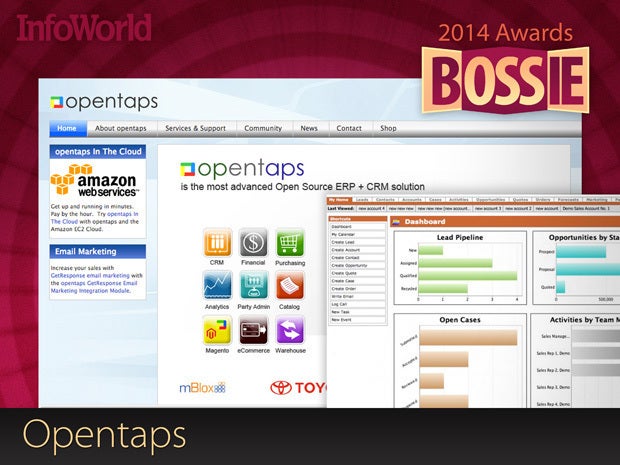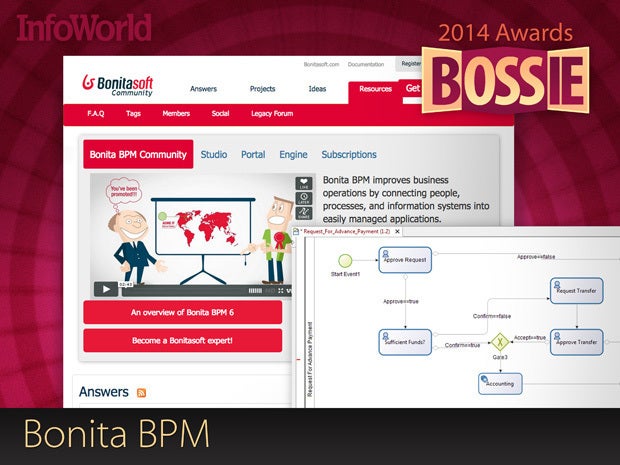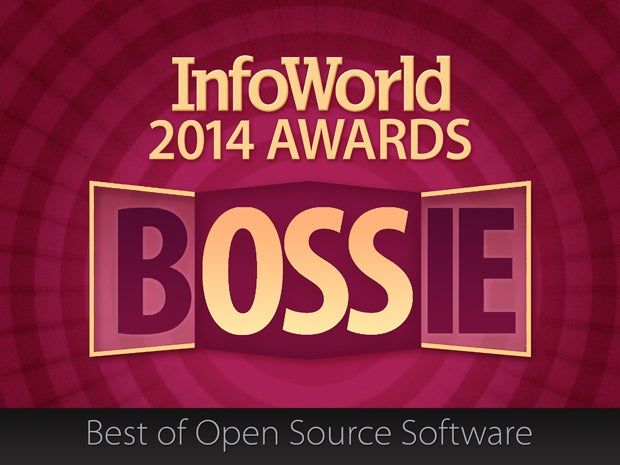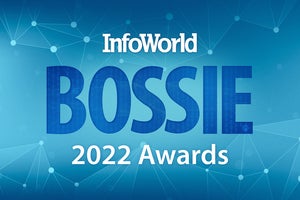Bossie Awards 2014: The best open source applications
InfoWorld's top picks of the year in open source business applications and middleware

The best open source applications
While many of these application projects have been around for years, they have not been sitting still. They've been creating mobile-friendly front ends, adding POS (point of sale) capabilities, providing integrations with other systems, and invariably, expanding the deployment options with SaaS editions. You'll find plenty that's new in this year's crop of open source apps.

ERPNext
The past year saw ERPNext move to a new Web framework, called Frappe, which supports plug-ins and extensions through a new API. In addition to the framework upgrade, the platform received a lot of usability improvements and bug fixes. The list of features is impressive and continues to grow. For example, the system now integrates a CMS, a B2C shopping cart, a customer portal, retail POS (point of sale), and bar code support.
Suitable for service companies, distributors, and light manufacturers, ERPNext supports both cloud-based and in-house deployments. Commercial/paid support is available for both versions. The community is steadily growing, as is the number of online customers, which helps to fund the project. It is easy to evaluate ERPNext for your specific needs by signing up for a 30-day trial of the cloud version or by downloading a virtual machine appliance to test the system in-house.
-- Fred Blauer

xTuple
The xTuple project continues the move to the new mobile and Web client platform based on the Enyo JavaScript framework. The new client will natively support all devices, while the database will continue to work with the current desktop client.
Like many open source ERP offerings, the free community edition of xTuple is suitable mainly for smaller business, while distributors, manufacturers, and larger organizations will need premium features available only in commercial editions. The company also offers an integrated e-commerce platform for selling online and dealing with business customers.
The company recently kicked off a month-long hackathon called haxTuple, whereby the community can contribute bug fixes and new features to win prizes.
-- Fred Blauer

Odoo
Formerly OpenERP, this project recently changed its name to Odoo. Newly released, version 8 brings many improvements, including a website builder, e-commerce, online events, Google Calendar sync and alerts, new warehouse management, a new reporting engine, better BI and data analysis, POS (point of sale) hardware integration, a new API, live chat/email marketing, and social media integration. The improvements are ambitious, and there is already a road map for version 9, which promises localization of accounting functions.
Built with Python, Odoo is completely Web-based and backed by a PostgreSQL database. You'll find many add-on modules from Odoo and third parties. Commercial support is available from Odoo directly or from the many partners around the world who also provide implementation services. A fully functional, online version of the system is free for two users, providing a way to evaluate the system with your own data without a time limit or having to do any server installation. You can always upgrade or move the system in-house in the future.
-- Fred Blauer

Openbravo
Openbravo is one of the earliest commercial open source ERP projects, forked from the Compiere code base. This is a Java-based technology stack backed by a PostgreSQL database and a model-driven development framework for customization.
Openbravo has a Web-based interface with offline capabilities and support for mobile devices. The latest improvements include embedded business analytics and more seamless integration with the Openbravo retail system, which is known as Openbravo Commerce. The many third-party extensions in the add-on marketplace include connectors to Magento eCommerce for online selling, and to SugarCRM for marketing and customer service.
Openbravo can be deployed in-house or in the cloud, and commercial support is available from local partners. This is a mature solution with some large implementations to its credit.
-- Fred Blauer

Opentaps
Opentaps is a full-featured ERP and CRM system built on the Apache OFBiz framework. Several other companies have used the OFBiz framework to build customizable enterprise systems, but Opentaps is the most advanced and most mature. A number of large companies are running on this platform. The current stable version is 1.5.x, and the next-generation 2.x is under development. Currently only the CRM system is running on the 2.x platform.
The project has released a free Google Mail extension that can pick up activities and contacts from a Gmail account, and integrates with the Opentaps ERP back end. It also supports integration with Magento eCommerce, and a SaaS-based analytics service is available for analyzing the ERP data. The system can be installed in-house or run from a virtual image on the Amazon cloud. There are various extensions in the commercial app store for enhanced financials, shipping integration, and training videos. Commercial support and services are available from project sponsor Open Source Strategies and its partners.
-- Fred Blauer

TimeTrex
TimeTrex is an open source payroll, employee scheduling, time and attendance, and job costing application. The standard edition is free, while the premium editions are open source but not free. All versions can be deployed either in-house or in the cloud. The payroll deduction calculations only support the United States and Canada.
The system is fully Web-based and requires PHP 5.3 or greater and a MySQL or PostgreSQL database (if the server is installed locally). There is an online demo for evaluation purposes, and a functional cloud-based community version (standard edition) is available for free. This is a good way to evaluate the system with your own data, without financial commitments. You can always upgrade in the future.
-- Fred Blauer

SugarCRM
The original open source CRM system, SugarCRM has one of the oldest and largest communities. It's available in a free community edition and paid commercial editions with premium features. The system runs on a standard LAMP software stack, which can be deployed either in-house or on the cloud. There is a free trial of the SaaS option, and you'll find the differences among the three commercial editions, as well as the pricing, detailed on the main site. The community edition, currently at version 6.5, includes standard CRM functionality but lacks richer essentials like dashboards and reporting. You'll find plenty of third-party add-ons in the SugarExchange.
The system is mature, reliable, and backed by a large ecosystem of partners and commercial entities that provide implementation services and support.
-- Fred Blauer

SuiteCRM
SuiteCRM was forked from the 6.5.x branch of SugarCRM because a segment of the community felt that SugarCRM Inc. was paying too much attention to its commercial editions and dragging its feet on updating the community edition. In addition to packaging up the latest SugarCRM codebase, SuiteCRM added a number of third-party extensions, resulting in a new system that is comparable to SugarCRM Professional in terms of features and functionality.
The SuiteCRM project is less than a year old, but it has a high degree of compatibility with SugarCRM, and the community is very active and growing. Commercial support and services are available from the project coordinator and a growing list of partners, many of whom also support SugarCRM.
-- Fred Blauer

Vtiger
A fork of SugarCRM 1.0, Vtiger CRM has been traveling its own separate path for 10 years. It's available in a free community edition and a subscription-based SaaS edition, which touts additional features, deeper reporting, security and uptime assurances, and ready integrations with PayPal, Magenta, and IP telephony services. New features are added to the SaaS version on a frequent basis, and some premium features don't make their way into the community edition.
The current version, 6.1, has an impressive list of features for the price. Commercial support is available from Vtiger for the SaaS edition, and from partners for the community edition. Many extensions and integrations are available in the Vtiger app store.
-- Fred Blauer

OrangeHRM
OrangeHRM covers employee tracking, time and leave management, and payroll administration. It's available in a free community version and commercially licensed professional and enterprise versions. All three versions support in-house and cloud installations. The main difference between community and commercial versions is the level of support and services, along with additional recruitment, performance review, training, and employee on/off boarding features in the commercial versions.
OrangeHRM runs on a standard LAMP stack with the Symfony PHP framework. Commercial support is available directly from the company or from local partners. A plug-in marketplace covers a number of add-on modules from OrangeHRM and third parties including an integration with the xTuple ERP system. The community is large and active, and the solution is mature and reliable. A July release brought mostly enhancements to security and data management.
-- Fred Blauer

Magento
Magento is the leading project for e-commerce solutions, backed by eBay, with a very large and active community and many high-profile clients. You'll find a large ecosystem of third-party add-ons and many local partners for implementation, support, and service. There is a free community version, and an enterprise version for larger companies. Magento recently announced it will close down its SaaS offering for smaller companies.
New features in the latest version 1.9 release include better support for mobile devices, an upgrade of PHP and the Zend framework, new features to support cross-border trade, improvements in the checkout system, security enhancements, and various fixes for taxes, the Web store, and shopping cart. Extensions and modules are available to integrate Magento with many of the open source ERP systems including Odoo and Openbravo.
-- Fred Blauer

Alfresco
Simply put, Alfresco is the only open source ECM (enterprise content management) system worth considering, thanks to a robust toolset for managing documents and digital assets. It plays well across a variety of content sources -- Microsoft SharePoint, Salesforce.com, even Apple iWork and Google Drive -- and Web-based file sharing and social collaboration are already baked in.
Alfresco's scalable platform is backed by a fully extensible ecosystem for custom development, along with easy deployment and ongoing administration. For document storage, publishing, and governance, Alfresco can flexibly meet both departmental and enterprise requirements.
-- James R. Borck

Bonita BPM
Bonita still paints the prettiest picture in open source BPM. The latest updates to the community edition included time-based tracking (to optimize process performance) and improved search, both nice enhancements, while the paid version added new premiums such as single sign-on, extended portal customization, and activity tweaking (to replay failed tasks, reassign cases, or reconfigure apps in process).
Bonita BPM Studio provides visual tools for rule building, drag-and-drop process configuration, and form creation, along with a broad range of prefab process diagrams and best-practice templates that let you capitalize on common workflow patterns. You'll also find good connectors to popular platforms such as Salesforce.com and SugarCRM.
-- James R. Borck

WordPress
The wildly successful blogging platform is much more than a blogging platform, thanks to its open-ended plug-in system. With WordPress, a simple blog can be transformed over time into a mini social network, a message board, a contact management system, and numerous other items. The rich culture of user-created themes for WordPress allows non-designers to ensure their blogs look stylish.
That said, the extreme open-endedness of WordPress means it needs to be managed with a careful eye and hand, especially considering many third-party add-ons and themes have been implicated as security hazards. But the sheer power of the core and the breadth of applications can't be dismissed.
-- Serdar Yegulalp

Ghost
WordPress may be the king of blogging software, but here comes a dark horse -- or, rather, a Ghost. Written in JavaScript and running on Node.js, Ghost is much more lightweight than WordPress, aimed at satisfying blogging needs rather than being a full-blown CMS. Posts are written in Markdown and rendered live in a parallel window for easy editing and previewing.
The project quickly attracted a massive developer community in a short time -- it's barely a year old, but has more than 2,500 forks on GitHub as of this writing. The Ghost app system (a way to turn Ghost into a full-blown platform) is a work in progress, and multi-user functionality is still on the to-do list. Nevertheless, it's impressive how much of the platform has already arrived.
-- Serdar Yegulalp

Drools
Over the years, Drools has evolved from simply a rule-based system to a BRMS (business rule management system). In the current version 6.1, you will now find six modules: Drools Expert (the rule-base itself), Guvnor (BRMS), jBPM (process/workflow), Workbench, Fusion (complex event processing), and OptaPlanner (automated planning). Mark Proctor, the original inventor, is still with Red Hat and still heads up the Drools effort.
All in all, Drools can't be considered a major competitor to FICO's Blaze Advisor and IBM's Operational Decision Manager, but is suitable for smaller BRMS applications that can live with being always in the "beta" mode of operation. If you need 24/7/365 factory support, as well as factory on-site consulting, you can always upgrade to JBoss Rules.
-- James C. Owen

Read about more open source winners
InfoWorld's Best of Open Source Awards for 2014 celebrate more than 130 excellent open source projects in nearly every corner of computing. Follow these links to more open source winners:
Bossie Awards 2014: The best open source applications
Bossie Awards 2014: The best open source application development software
Bossie Awards 2014: The best open source big data tools
Bossie Awards 2014: The best open source data center and cloud software
Bossie Awards 2014: The best open source desktop and mobile software
Bossie Awards 2014: The best open source networking and security software
Copyright © 2014 IDG Communications, Inc.


























